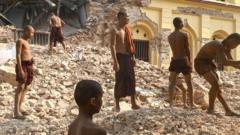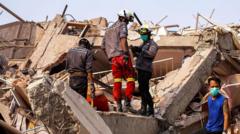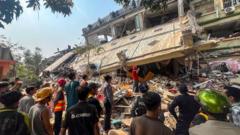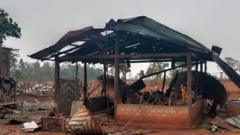A powerful earthquake struck Myanmar, resulting in significant destruction and loss of life. Surprisingly, it also caused the collapse of a building in Bangkok, highlighting vulnerabilities in construction and geological factors in both regions.**
Understanding the 7.7-magnitude Myanmar Earthquake and Its Impact on Bangkok**
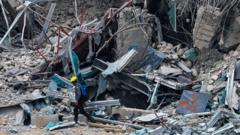
Understanding the 7.7-magnitude Myanmar Earthquake and Its Impact on Bangkok**
An examination of the recent Myanmar earthquake and its far-reaching consequences, including the collapse of an unfinished skyscraper in Bangkok.**
On Friday, a powerful 7.7-magnitude earthquake struck Myanmar, causing over 1,000 fatalities and widespread destruction. Despite Myanmar's known seismic risks, the tremor had unexpected effects even in Bangkok, over 1,000 kilometers away, where an unfinished skyscraper collapsed.
The earthquake's origins can be traced to the convergence of four tectonic plates: the Eurasian, Indian, Sunda, and Burma microplates, with significant geological activity occurring in Myanmar. Dr. Rebecca Bell from Imperial College London explained that this region's active geology creates faults, such as the extensive Sagaing fault running across Myanmar, which allows for strike-slip movements where two blocks slide past each other horizontally. As friction builds along these faults, it can lead to substantial seismic events.
One reason this earthquake had such a far-reaching impact was its shallow depth of only 10 kilometers, leading to greater shaking at the surface and making it feel more intense even at great distances. The earthquake's magnitude, combined with the geological conditions in Bangkok, contributed to the unexpected consequences. The city’s soft soil amplified seismic waves, which led to increased shaking stronger than normal.
While videos captured buildings in Bangkok swaying, the under-construction headquarters of the auditor-general was the only high-rise to collapse. Previous safety standards for earthquake-resistant buildings were inadequate; however, recent updates should have applied to new structures. Dr. Christian Málaga-Chuquitaype noted that the construction method used— a flat slab technique— is less effective in resisting earthquakes and led to the catastrophic failure of this building.
In contrast, buildings in Myanmar, particularly in Mandalay, faced the intense shaking directly. Despite the region's frequent earthquakes, awareness and preparedness for seismic resilience remain low, partly due to poverty and political issues. This neglect has led to poor compliance with building codes and constructions in vulnerable areas susceptible to ground liquefaction during quakes.
Experts warn of potential aftershocks that could cause further devastation in both Myanmar and neighboring regions. The events of this earthquake serve as a stark reminder of the importance of building resilience against natural disasters and emphasize the vulnerabilities persistently faced by communities residing in seismic zones.

